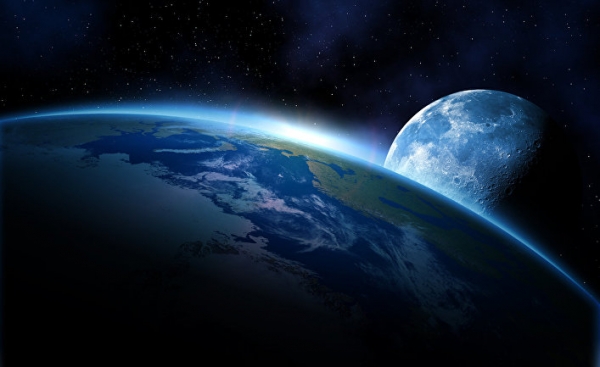
Ethan Siegel (Ethan Siegel)
You have already met with a similar analogy: the atoms resemble the solar system, the large-scale structure of the universe similar to the neurons in the human brain, but there is another curious coincidence: the number of stars in the galaxy, galaxies in the universe, of atoms in the cell and cells in a living being about the same (from 10^11 to 10^14). The following question arises, how it has formulated and Mike Hughes (Mike Hughes Paul):
Aren’t we just a brain cell of a larger creation on a planetary scale, which does not yet possess self-awareness? How can we know? How can we test?
Believe or not, but the idea that the total amount of everything in the universe is an intelligent creation, there is a very long time and is part of the marvel Universe (Marvel Universe) and the finite beings of Eternity.
It is difficult to give a direct answer to such a question, because we are not 100% sure that, actually, means consciousness and self-consciousness. But we have the assurance of a relatively small number of physical things that can help us find the best possible answers to this question, including the answers to the following questions:
— What is the age of the Universe?
— How long different objects are forced to send each other signals to and receive signals from each other?
— How large are the largest structures associated with gravity?
— And how many signals of the bound and unbound structures of different sizes will be forced to have to share with each other information of any kind?
If we do such calculations and then compare them with the data that arise even in the simplest structures, like the brain, we then at least will be able to give the closest of all possible answers to the question, is there anywhere in the universe large space structures, vested with reasonable powers.
Universe since Big Bang there are about 13,8 billion years old, and she has since that time expanded quite fast (but declining) growth rates, and it consists of about 68% dark energy, 27% dark matter, 4.9% of normal matter, 0.1% of neutrinos, and about 0.01% of the photons (The percentage used was different — in a time when matter and radiation were more significant).
Since light always travels at the speed of light through the expanding universe, we are able to determine the number of different communications were made between the two objects captured by this expansion process. If we define “communication” as the amount of time required for transmission and reception of information in one direction, then this is the way that we can do for 13.8 billion years:
— 1 communication: up to 46 billion light years, the entire observable universe;
10 — communication: up to 2 billion light years, or about 0.001% of the universe; the next 10 million galaxies.
— 100 communications: almost 300 million light-years or incomplete distance of Coma Cluster (Coma Cluster), which contains about 100 thousand galaxies.
— 1000 communications: 44 million light-years away, almost on the boundaries of Superclusters Virgo (Virgo cluster) containing approximately 400 galaxies.
— 100 thousand communications: 138 thousand light years or nearly the entire length of the milky way, but not going beyond it.
— 1 billion communications — 14 light-years or just the next 35 (or so) stars and brown dwarfs; this is an indicator changes as the motion of stars inside a galaxy.
Our local group has a gravitational connection — it consists of us, Andromeda, the Galaxy of the Triangle (Triangulum galaxy) and even, perhaps, 50 other, much smaller dwarfs, and in the end, all together they form a single connected structure of several hundreds of thousands of light years (It will more or less depend on the magnitude of the associated tree). Most groups and clusters will face the same fate: all associated galaxies within them together form a single, giant structure the size of several hundred thousand light years, and this structure will exist for about 110^15 years. At a time when the age of the universe will be in 100 thousand times higher than its current rate, the last star will use up its fuel and will be plunged into darkness, and only very rare outbreaks and collisions will again cause the synthesis, and it will continue until until the objects begin to separate gravitational — during the time frame of 10^17 to 10^22 years.
However, these large groups will increasingly speed away from each other, and therefore they will not have the opportunity to meet or communicate with each other over a long period of time. If we, for example, sent a signal today from our place at the speed of light, we could achieve only 3% of galaxies observed in the present universe, and the rest is already beyond reach for us. Therefore, a separate, related groups or clusters — that’s the best we can hope for, and the smallest, as we — as most of them contain about one trillion (10^12) stars, whereas the largest (as in the future the Coma Cluster) contain about 10^15 stars.
But if we want to detect the identity, the best option would be comparison with a human brain has about 100 billion (10^11) neurons and at least 100 trillion (10^14) neural connections, while each neuron flashes approximately 200 times per second. Assuming that human life on average lasts around 2-3 billion seconds, we get a lot of signals for the entire period! You will need a network of trillions of stars within the volume in a million light years for 10^15 years just to get something comparable with the amount of neurons, neural connections and the volume of transmitted signals in the human brain. In other words, these aggregate numbers for the human brain and large, fully formed galaxies end — are, in fact, comparable with each other.
However, essential distinction is that neurons inside the brain and have associated certain structures, while stars inside galaxies or related groups, moving quickly, moving either towards each other or away from each other that occurs under the influence of all other stars and the mass inside the galaxy. We believe that such method of random selection of sources and orientations makes it impossible to form any stable signal structures, however, it may be necessary, and it might not be. Based on our knowledge of how consciousness arises (particularly in the brain), I think that is simply insufficient consistent information is moved between different entities to make this possible.
However, the total number of signals that can participate in exchanges at the galactic level in the period of existence of the stars, is attractive and interesting, and it indicates a potential relative to the number of information exchanges available to another thing we know is that it has identity. However, it is important to note the following: even if we could, then our galaxy would be equivalent to a newborn baby, born just 6 hours ago — not too great result. As for the larger consciousness, it hasn’t appeared yet.
Moreover, we can say that the concept of “eternity”, which includes all the stars and galaxies in the universe is undoubtedly too great, given the existence of dark energy and what is known regarding the fate of our universe. Unfortunately, the only way to find out based on simulation (this variant has its own internal flaws), or on the seat, waiting and watching what happens. Until more large-scale reason will not direct us the obvious “reasonable” signal, we will remain the only choice the count of Monte Cristo: wait and hope.
Ethan Siegel is the founder of the blog Starts With A Bang, the NASA Explorer and Professor of Lewis and Clark (Lewis & Clark).






